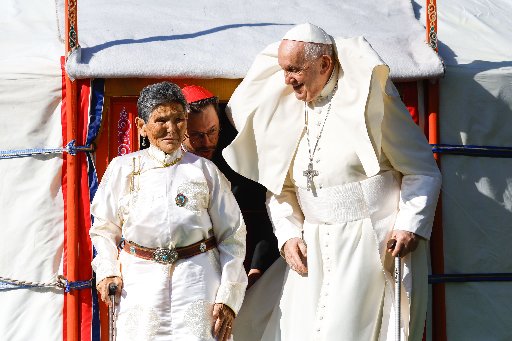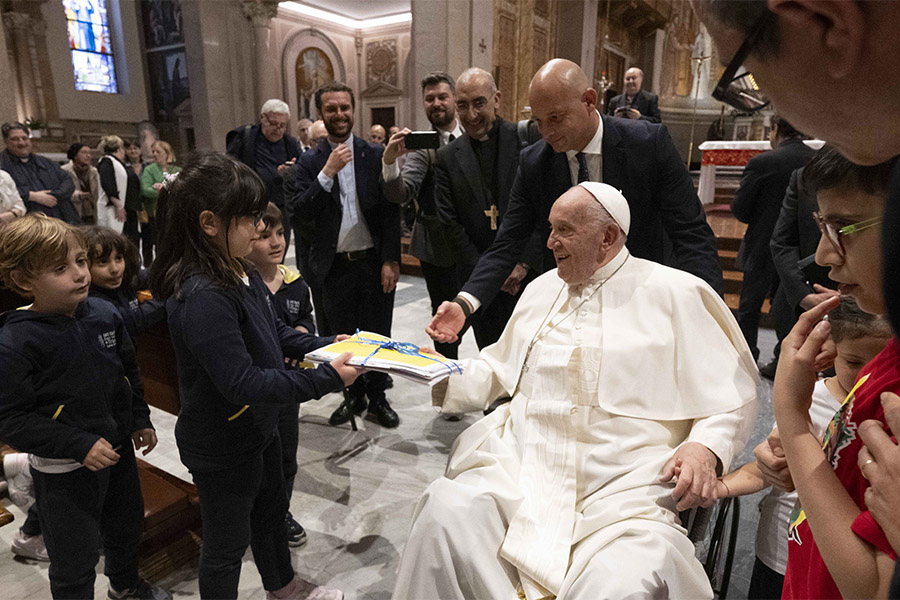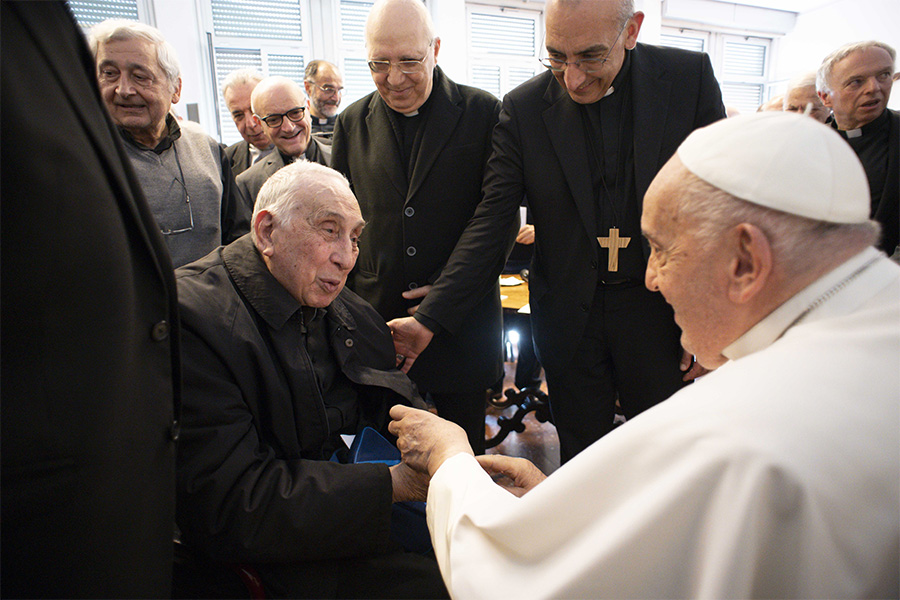ULAANBAATAR, Mongolia (CNS) — In a cathedral shaped like a ger, Pope Francis met leaders of Mongolia’s tiny Catholic community, offering them encouragement but also reminding them that faith and unity must be at the center of their lives.
Without daily prayer and respect for the structure and unity of the church, “our strength will fail, and our pastoral work will risk becoming an empty delivery of services, a roster of duties that end up inducing only weariness and frustration,” the pope said Sept. 2.

At the Cathedral of Sts. Peter and Paul in Ulaanbaatar, the pope met with Cardinal Giorgio Marengo, apostolic prefect of Ulaanbaatar, and with the priests, religious and lay volunteers who minister to Mongolia’s 1,450 Catholics and offer education, health care, food, shelter and other social support to thousands of others.
Bishop José Luis Mumbiela Sierra, head of the Diocese of the Holy Trinity in Almaty, Kazakhstan, and president of the Catholic Bishops’ Conference of Central Asia, and other bishops from the region also attended the meeting.
Before entering the cathedral, Pope Francis was welcomed with a glass of milk at a ger, a traditional Mongolian dwelling, on the cathedral grounds. He went inside and met Tsetsege, a Mongolian woman who uses only one name, who had found a statue of Mary in a garbage landfill before Christian missionaries arrived in the country. She showed it to the first Catholic she met, a Salesian sister, and it is now venerated inside the cathedral as Our Lady of Heaven.
Consolata Father Ernesto Viscardi, who has been in Mongolia for 19 years, told reporters, “It’s a great surprise” that the pope would travel so far to visit “the world’s smallest Catholic community,” but it also is the “Bergoglio style,” a reference to the pope’s family name.
The papal visit brings the world’s attention to Mongolia, he said, but it also is a powerful sign to Mongolian Catholics that they are part of a universal church.
The big challenges for Catholic missionaries in the country, he said, are: finding ways to connect with young people, making the church truly Mongolian — “otherwise we’d just be colonizing again” — and, finally, continuing to serve the poor and hurting while being mindful that that is not the “foreign NGO” that it is in the eyes of the government.
Pope Francis praised the churchworkers for making love for the poor their “calling card” but assured the government and those suspicious of the church that “the Lord Jesus, in sending his disciples into the world, did not send them to spread political theories, but to bear witness by their lives to the newness of his relationship with his Father, now ‘our Father.'”
“Governments and secular institutions have nothing to fear from the church’s work of evangelization,” he said, because the church “has no political agenda to advance but is sustained by the quiet power of God’s grace and a message of mercy and truth, which is meant to promote the good of all.”
With missionaries coming from dozens of countries and trying to form one Catholic community with Mongolian Catholics, Pope Francis insisted “unity in the church is not about order and respect, nor is it simply a good strategy for ‘teamwork.'”
Communion, he said, is “about faith and love for the Lord, about fidelity to him. Consequently, it is important for all ecclesial elements to remain firmly united around the bishop, who represents Christ alive in the midst of his people, and to build up the synodal fellowship that we preach and that greatly assists the inculturation of the faith.”
Pope Francis listened to the “testimonies” of three people: a member of the Missionaries of Charity, a lay catechist and one of only two Mongolia-born priests.
Sister Salvia Mary Vandanakara told the pope about arriving in 1998 and living among the poorest of the poor, as St. Teresa of Kolkata taught her sisters. An early activity was organizing classes for children who risked not finishing school, she said. One of those boys is now a priest.
The priest, Father Peter Sanjaajav, told the pope his visit tells Mongolians that God “is by people’s side, by the side of us Mongolians. It is wonderful to understand that God is so close to our daily life.”
And Rufina Chamingerel, a lay pastoral worker, told the pope the young church in Mongolia — which opened to missionaries only in the 1990s after decades of communist repression — “is in that phase typical of children who constantly ask their parents questions.”
Mongolian Catholics rejoiced last year when Pope Francis made their apostolic prefect, Bishop Marengo, a cardinal, she said. But they didn’t know what a cardinal was.
She thanked Pope Francis for the current process for the “synod on synodality,” which, she said, is giving local Catholics, especially catechists and other pastoral workers, a chance to discover “the true nature of the church.”
Chamingerel also told the pope she thinks Mongolian Catholics “are very lucky” that there are not many catechisms or other Catholic educational materials in their local language, “but we have many missionaries who are living books.”
Also see
But the pope also expressed hope that ongoing negotiations between the Vatican and Mongolia as well as new legislation might make it easier for Catholic missionaries to enter the country and build up their work not only evangelizing, but also providing education and a wide variety of social services.
Copyright © 2023 Catholic News Service/U.S. Conference of Catholic Bishops







